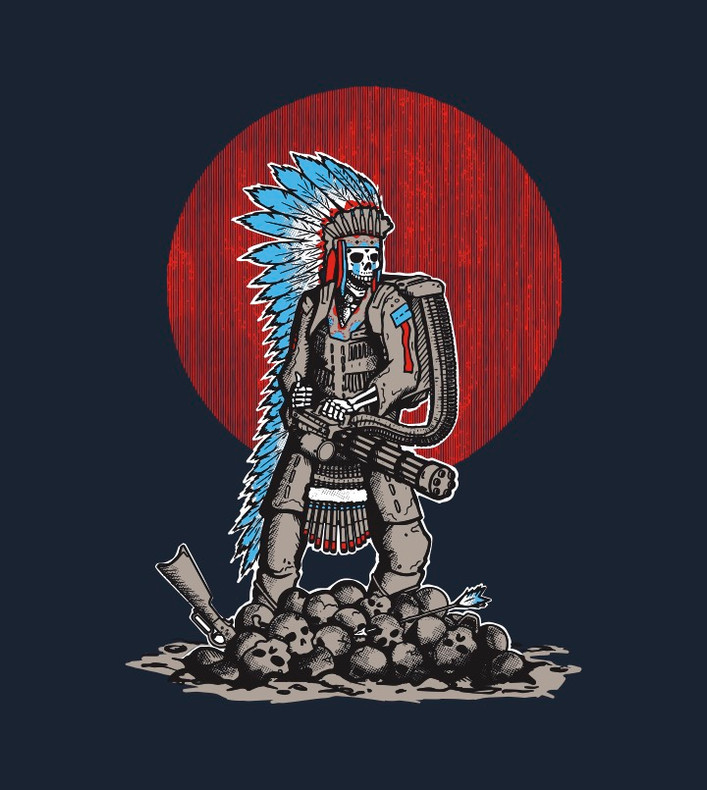History & War -
The Lakota Native American tribe, also known as the Sioux, are a group of indigenous people who originally inhabited the Great Plains region of North America. The Lakota people have a rich and complex history, with a unique culture and way of life that has been shaped by their environment, traditions, and interactions with other tribes and European settlers.
The Lakota were originally part of the larger Sioux Nation, which also included the Dakota and Nakota tribes. The Sioux Nation was a nomadic people who followed the buffalo herds across the Great Plains, living in tipis and relying on the buffalo for food, clothing, and shelter. They were also known for their expert horsemanship and hunting skills, and were feared by other tribes for their prowess in battle.
In the 18th and 19th centuries, the Lakota people came into contact with European settlers, who were expanding westward across North America. They initially traded with the settlers, but tensions soon arose as the settlers began to encroach on Lakota territory and disrupt their way of life. The tribes fought back against the settlers in a series of conflicts known as the Sioux Wars, which lasted from the 1850s to the 1890s.
One of the most famous battles of the Sioux Wars was the Battle of Little Bighorn, in which a Lakota-led coalition of tribes defeated a U.S. Army force led by General George Custer. The Lakota people were ultimately defeated by the U.S. Army, however, and were forced to live on reservations in South Dakota and other parts of the Great Plains.
Despite the hardships they faced, the Lakota people have maintained their culture and traditions, and continue to practice their traditional way of life. They have a rich oral tradition, with stories and legends passed down from generation to generation. Their spiritual connection and tradition is strong, with a belief in the interconnectedness of all things and a deep reverence for the natural world.
Today, this fierce tribe continues to face challenges, including poverty, unemployment, and health issues. However, they remain a proud and resilient people, with a strong sense of community and a commitment to preserving their culture and way of life. The Lakota people have made significant contributions to American history and culture, and their legacy continues to inspire and educate people around the world.
The War -
The Lakota were defeated by the U.S. Army through a combination of military force, political pressure, and economic coercion.
One of the key factors in their defeat was the superior military technology and tactics of the U.S. Army. The Lakota were skilled warriors, but they were no match for the firepower of the U.S. Army, which had access to advanced weapons such as repeating rifles, Gatling guns, and artillery. The U.S. Army also had a larger and better-trained force, with experienced officers and soldiers who were able to coordinate their attacks and exploit the weaknesses of the Lakota.
Another component in the demise of this once strong and independent tribe was political pressure. The U.S. government was determined to expand westward and settle the Great Plains, and saw the Lakota as an obstacle to this goal. The government used a variety of tactics to pressure indigenous people into giving up their land, including treaties, promises of food and supplies, and threats of military force. When the Lakota refused to comply with these demands, the government sent in the army to enforce its will.
Economic coercion was also a factor in the defeat of the Lakota. The U.S. government sought to undermine the traditional Native American way of life by encouraging them to adopt a sedentary lifestyle and become farmers. The government provided food and supplies to the Lakota on the condition that they give up their nomadic lifestyle and settle on reservations. This policy was designed to weaken the Lakota's independence and force them to become dependent on the government for their survival.
Despite these challenges, the Lakota people have remained resilient and have continued to preserve their culture and traditions. Our Native American image is meant to show how fierce these tribes are, how they faced insurmountable odds and never gave up, even to this day.
Always fight tyranny and those who wish to rule over you. Never give up what you believe in, and most importantly.. DEFEND YOUR TRIBE.
Black On Ammo

